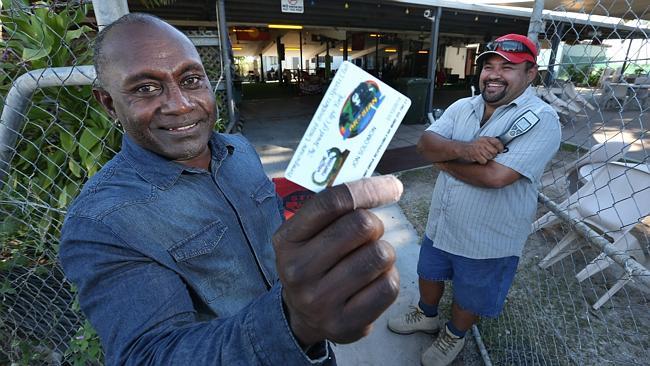Keeping a lid on drink
ALCOHOL plans have improved life in remote communities.

IT’S only at dark the children come out of the mangroves.
Dirty, scratched-up and stinking from the mud, some are so mindlessly drunk they can’t even find their way home in the small township on Mornington Island.
The mangroves are the makeshift “beer garden’’ for the 1200-strong local population, in the Gulf of Carpentaria, one of Queensland’s supposedly “dry’’’ Aboriginal communities.
In the crocodile-infested tangle of mangroves, it is easy to find a drink.
Rubbish bins and plastic tubs stand out like beacons in the swamp, full of the potent home brew that has become the staple since grog was banned on the island in 2003.
A toxic mix — with an alcohol content that can exceed 25 per cent — it is easy to make, with a few litres of fruit juice, sugar and a tub of Vegemite (providing the yeast) left to stand for a couple of days before it is ready.
Every day, scores of locals — including, sometimes, children — go out into the mangroves and drink until they drop.
“The kids, we are talking 12, 13 and 14 years of age — have been taught by the adults how to make the brew, it’s not hard,’’ one elder, who asks to remain anonymous, tells The Australian.
“They are out there writing themselves off or selling it; it’s the easiest way to turn $20 into $200.
“At night, the ones that can walk come out of the swamp, blind drunk.’’
The rise of home brewing — which has led to increasing hospitalisations and even deaths — as well as sly-grogging is one of the awful side effects of the alcohol restrictions that now cover Queensland’s 19 remote indigenous communities.
Progressively introduced by the Beattie government, the Alcohol Management Plans — which vary from limits on takeaway sales to total bans — were imposed following the landmark report by corruption fighter and former judge Tony Fitzgerald into the numbing social dysfunction across the communities.
Alcohol-fuelled violence, child abuse and neglect had been allowed to fester for decades in the small townships, with local councils running, and profiteering from, the “canteen’’ where the grog flowed most of the day and night.
With indigenous leaders such as Noel Pearson, journalist Tony Koch and Cape York doctor Lara Wieland, the Queensland government was pushed into commissioning the inquiry and then, on the recommendation of Fitzgerald, turning off the tap.
It worked.
Queensland government data from the communities, from 2002 to 2013, show reported violence and hospitalisations decreased significantly in many, with child-abuse notifications more than halving in parts of Cape York.
Opponents of the restrictions, and there are many, claim the figures are not uniform and that in some townships, such as Mapoon, a comparatively genial community, the number of hospitalisations through assault has actually risen over the period.
But there is no one — sober — in the communities who could honestly say the AMPs have not improved life.
The chaos that spilled out of the canteens is gone, more kids are going to school and the streets are safe.
So it was hardly surprising that when Campbell Newman, after becoming Queensland Premier in March 2012, announced a review of the AMPs the issue blew up.
It had not been on the political agenda until midway through the election campaign.
Asked by a journalist about his view on AMPs, the former Brisbane lord mayor questioned why aborigines shouldn’t be able to come home after work and have a beer, just like anyone else in the state.
It may have won some Aboriginal votes, as Labor later argued, in seats in north Queensland that they later lost, but the review — launched in October 2012 — sparked outrage when the government readily conceded it would lead to a relaxation of restrictions in some communities.
Pearson later wrote in The Weekend Australian how he had “shivered with concern’’ at the prospect of the grog controls being rolled back; Marcia Langton, a professor of indigenous studies at the University of Melbourne who worked in Cape York earlier in her career, warned that 20 years of effort to contain the devastating effect of alcohol abuse would be destroyed.
And the woman who led the federal intervention into Northern Territory Aboriginal communities, Sue Gordon, insisted no one but the suppliers of booze would benefit.
But, 20 months on, as the Newman government is about to consider a raft of submissions from communities, the blanket opposition to any relaxation of the laws is waning.
Even Pearson, earlier this year, offered his conditional support to a proposal to trial an “alcohol permit system’’ that would allow residents of the dry community of Napranum, on the western side of Cape York, to drink mid-strength alcohol at home.
Under the plan, the permit would be revoked if a holder committed any alcohol-related offence, drank outside an approved residence or even if the police were called due to an “alcohol-related incident’’.
Pearson, who still holds concerns about turning on the tap, said he would back a system allowing people to drink if they held a job, stayed out of trouble and ensured their children went to school. “If there is a model that can encourage responsible drinking then I think it is worth trialling,’’ he said in February. “The ideal position is that we don’t have alcohol in Aboriginal communities because alcohol and the strong kinship don’t mix, they drink until there is nothing left.
“But if indigenous communities insist that they have the same rights as other Australians to have a drink, then they have to learn to drink responsibly like the Greek people, the Chinese people, the white fellas.’’
The Napranum plan, the first to be submitted to the government for approval, has since been rejected because it called on the police to issue and manage the permits. It is understood the police refused to manage the system because they didn’t want to get bogged down with paperwork.
Police generally don’t like the idea of lifting the restrictions. After the review was announced, police privately wrote to the government expressing fears that a relaxation of the laws would lead to a spike in “violence, child abuse and officer burnout’’.
Under the review, the Newman government has called on the councils in each of the 19 indigenous communities to consult their residents and, if change is supported, come up with an AMP of their own.
Newman and his Indigenous Affairs Minister, Glen Elmes, warned that cabinet would not approve any changes unless the community could show violence was “trending down and school attendance trending up’’ and that it would stay that way under any changes.
Elmes says there is no way that restrictions would be completely lifted. “We were never going to allow the free flow of alcohol, we wouldn’t ever allow a return to the canteen days or anything close to that,’’ he says.
However, the councils — despite absolute opposition to the AMPs from some leaders, including Palm Island Mayor Alf Lacey — have not rushed in with submissions.
One of the reasons was that many were waiting on the outcome of the High Court challenge, led by Lacey, to the laws. In June last year, the court upheld the legality of the grog restrictions.
The High Court acknowledged that AMPs were racially discriminatory, but ruled they were lawful under section 8 of the Constitution, which permits “special measures’’ to protect groups of people.
Lacey, who had been among hundreds of residents throughout Queensland who have been charged with breaching the AMPs by being caught in possession of banned grog, branded the ruling “paternalistic’’.
Palm Island is expected to be among at least six councils that will submit draft AMPs for cabinet approval in the next few months.
Only two communities — Aurukun and Lockhart River — have told the government they want to maintain the status quo and stay dry. The rest are moving towards pushing two different plans: the opening-up of a “sports club’’ with closely monitored drinking or the introduction of a “drinking licence’’, similar to that proposed at Napranum.
Elmes says a sports club in Pormpuraaw, on the western side of Cape York, is a model for the community.
Assistant manager Patrick Gibuma says the residents are breathalysed before they enter the club, and are not allowed in if they register alcohol in their system.
They are then allowed to buy six mid-strength and three low-strength cans, which is monitored through the drinker’s digitalised card that has to be presented with each purchase.
“It has taken a lot of work to get the system working, but there is no way that anyone can come to the club if they have been drinking and they can’t exceed the limit,’’ Gibuma says.
“This club encourages the social aspects of drinking; you can’t get drunk and if there is any trouble you are out. People have learned to be responsible drinkers.’’
On Mornington Island, the council wants to introduce a “drinking licence’’ system.
Under the plan — which has yet to be finalised — a resident would be given a licence if they were deemed healthy, their kids were in school and the house was in order.
However, Mayor Bradley Wilson says any change in the AMP has to come with a boost in rehabilitation services and a heavier hand by police on sly groggers and brewers.
“We need drop-in centres for people who are drunk, we need support services and we need to do something about home brew,’’ he says.
Wieland, who championed the AMPs, says one of the problems of the alcohol restrictions over the past decade has been a reluctance of the courts to impose strong sanctions on people who sly-grog or brew in the communities.
“Fitzgerald recommended a range of things beyond alcohol restrictions, tackling unemployment and lack of economic opportunity, but they weren’t pursued,’’ she says. “AMPs have made a difference.”
Wieland says she would support some lifting of restrictions, but only if there were tight controls and the courts took a harder line on those who breached AMPs.
It is a sentiment echoed in Aurukun, the largest indigenous community on Cape York, which intends to remain dry.
Aurukun Mayor Dereck Walpo says the only changes he wants to the ban on grog in his community is for tougher sentences to be handed down to people who sly-grog.
“We are talking to the government, we want people who bring in the grog to lose their cars, to be sent to prison,’’ he says.



